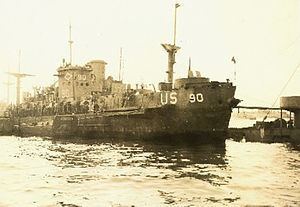Length 48 m | Beam 23 ft 3 in (7.09 m) | |
 | ||
Name USS LCI(L)-90 / USS LCI(G)-90 Displacement 216 t.(light), 234 t.(landing), 389 t.(loaded) Draft Light, 3 ft 1.5 in (0.953 m) meanLanding, 2 ft 8 in (0.81 m) fwd, 4 ft 10 in (1.47 m) aftLoaded, 5 ft 4 in (1.63 m) fwd, 5 ft 11 in (1.80 m) aft Propulsion 2 sets of 4 General Motors diesels, 4 per shaft, BHP 1,600, twin variable pitch propellers | ||
USS LCI(L)-90 was an amphibious assault ship manned by a United States Coast Guard crew. She was commissioned in 1943 and was used to land troops in the landings on French North Africa, Sicily and Anzio in 1943, and at Omaha Beach during the Invasion of Normandy in 1944. She participated in the invasion of Okinawa, where she was attacked by a Japanese kamikaze fighter.
Her two commanding officers were William E. Stevens and William H. Nadon, who were both Lieutenant junior grade, of the Coast Guard.
William Trump a seaman who volunteered to go ashore before the troops, at Omaha Beach, and lay out a cable through a safe path to shore, was awarded a Silver Star.
According to Harold Baier, a soldier who landed from LCI-90 during the Invasion of Normandy, the vessel's doors were damaged by enemy fire.
During the Invasion of Okinawa LCI-90 was damaged by a kamikaze, after she had landed her soldiers, and one seaman was killed.
